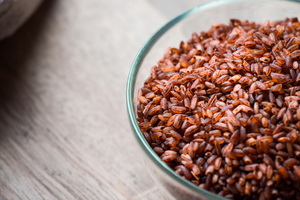
CRISPR-Cas9 Used to Recover Red Pigmentation in Elite Rice Varieties
May 8, 2019| |
 Rice is a major staple food crop for over half of the global population. It is known for having white grains, but some varieties exhibit pigmented grains such as red rice. Red rice has high concentrations of healthful proanthocyanidins and anthocyanins. Two complementary genes (Rc and Rd) control the red coloration of rice grains. Wild rice species Oryza rufipogon has red grains, while most cultivated varieties have white grains due to a deletion in the Rc gene.
Rice is a major staple food crop for over half of the global population. It is known for having white grains, but some varieties exhibit pigmented grains such as red rice. Red rice has high concentrations of healthful proanthocyanidins and anthocyanins. Two complementary genes (Rc and Rd) control the red coloration of rice grains. Wild rice species Oryza rufipogon has red grains, while most cultivated varieties have white grains due to a deletion in the Rc gene.
Scientists from Xiamen University and Fujian Academy of Agricultural Sciences used CRISPR-Cas9 to restore the deleted portion of the Rc gene. This successfully converted three elite white grain rice varieties into rice plants with red grains, producing high levels of proanthocyanidins and anthocyanidins. Furthermore, no significant change in major agronomic traits was observed in the mutants compared to the wild type, implying that restoring the Rc function had no effect on agronomic traits in rice.
Read the research article in Plant Biotechnology Journal.
| |
Biotech Updates is a weekly newsletter of ISAAA, a not-for-profit organization. It is distributed for free to over 22,000 subscribers worldwide to inform them about the key developments in biosciences, especially in biotechnology. Your support will help us in our mission to feed the world with knowledge. You can help by donating as little as $10.
-
See more articles:
-
News from Around the World
- Global Team Sequences 429 Chickpea Lines from 45 Countries to Develop High-Yielding, Climate Resilient Crop
- Genome Analysis of African Yam Backs Niger River as Cradle of African Agriculture
- Scientists Release Most Accurate Peanut Genome Sequence to Date
- Researchers Identify Cause of Seed Abortion and Role of RNA Pol IV Enzyme in Seed Development
- New Gene Metrics Increase Precision of Plant Breeding Technology
- Climate Extremes Explain 18%-43% of Global Crop Yield Variations
- Genomes of 480 Wheat Varieties Reveal Evolution, Human Sociocultural History
- Study Reveals Climate Change Boosts Banana Disease
- Healthful Oils from GM Plant as Effective as Fish Oil
-
Research Highlights
- Experts Characterize Cadmium-responsive MiRNAs and their Target Genes in Maize
-
Announcements
- ASEAN-U.S. Science Prize for Women
-
Resources
- Interactive Map Shows Crop Field Trial Sites in Australia
-
Plant
- Study Shows How Nature Makes Solution to Hidden Mutations
- CRISPR-Cas9 Used to Recover Red Pigmentation in Elite Rice Varieties
-
Read the latest: - Biotech Updates (December 3, 2025)
- Gene Editing Supplement (November 26, 2025)
- Gene Drive Supplement (February 22, 2023)
-
Subscribe to BU: - Share
- Tweet
